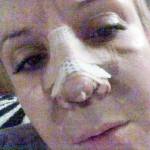Rhinoplasty Bump Reduction
Reduction of a nasal bump is one of the most common reason patients seek rhinoplasty. Looking at your profile on the photograph, it looks like you nasal tip may be overprojected as well.
Seek a live consulation with an experiencd rhinoplasty surgeon to review your goals for rhinoplasty.
This should not be an extraordinarily difficult case, but hard to determine without examining you in person. (Sumit Bapna, MD, Columbus Facial Plastic Surgeon)
Dorsal bump and rhinoplasty
Removal of a dorsal bump is common with rhinoplasty. It is important that the surgeon address the change in the nasal airway with removal of a large hump with possible need for spreader grafts etc. (Donald Nunn, MD, Atlanta Plastic Surgeon)
Rhinoplasty for dorsal bump
Reducing a nasal bump is a common reason for seeking rhinoplasty, and it would not make your surgery complicated or difficult.
When you have a consultation for rhinoplasty, the surgeon will look at your nose from all angles, look inside the nose, see if you have difficulty breathing, and assess what you need for both the best function and best appearance. It is key to communicate what you dislike about your nose and if you are having any difficulty breathing. It is also very important to find a surgeon who has experience with rhinoplasty and has results that you like (look at the before and after photos). (Anita Patel, MD, Beverly Hills Plastic Surgeon)
Bump Reduction Nose Job – Reduction Rhinoplasty
Simply put, the appearance of the outside of the nose is not as indicative of complexity as what awaits the Plastic surgeon inside the nose. The CONDITION, SHAPE and LOCATION of the SEPTUM and the INFERIOR TURBINATES would largely determine how the nose would be reduced.
In the most common scenario, if the structures above do not require correction, the hump (made mostly of cartilage and a little bone is removed and then the side walls of the nose are moved in after a controlled fracture along the sides of the nose.
This may be combined with strip grafting of cartilage along the upper portion of the septum to decrease the possibility of restricted breathing. Consult a Plastic surgeon to learn what would be best for you. (Peter A. Aldea, MD, Memphis Plastic Surgeon)
If I Decided to Get my Nose Done Would the Surgery Be Complicated Because of my Bump?
Removal of a dorsal bump has to be discussed with your surgeon of choice, as results can vary. Although removing a bump is a simple technical process, the results are very variable depending on the skill of the surgeon. Too much resection will leave you with the traditional “ski slope”. Some patients request a slight fullness rather than a straight bridge.
When removing a bump, support of the lateral walls may need to be addressed to prevent the traditional nasal valve collapse, that may not become evident until months after surgery.
I recommend you consult with an experienced rhinoplasty surgeon in your area, and that computer imaging is performed to make sure that the vision you have is compatible with that of your surgeon. (Michel Siegel, MD, Houston Facial Plastic Surgeon)
The small nasal hump
It is possible for some to reduce the hump without infracture. In LA years ago, this was marketed as the lunch hour rhinoplasty. Most often the infracture is needed to close the ‘roof’ of the nose and reduce the flatness which can result. (Peter E. Johnson, MD, Chicago Plastic Surgeon)
Do You Need to Break the Nose for This Bump?
From the photos provided, it does appear to be a small dorsal hump. A straight profile shot is required to verify this is indeed the case. During rhinoplasty bump, when reducing slight bony dorsal humps, rasping with a bone file is sufficient at removing the bump.
If the hump is greater than 2-3 mm’s, an “open roof” deformity is caused by the hump removal which requires breaking the bones in order to close the open roof. (Francis R. Palmer, III, MD, Beverly Hills Facial Plastic Surgeon)
It would be better to submit a true lateral picture but, since the hump does not appear particularly prominent, there is a CHANCE that your profile can be improved without breaking the bones.
This decision has to be made during the surgery sometimes. Once the hump is shaved down to the desired profile, the surgeon feels the bones and must perform an osteotomy if there is a gap between the bones.
Not doing so will result in an open roof deformity with a wide, flat appearance. Sometimes the surgeon has to have your understanding that he will not break the bones unless necessary, but that the decision is his and his alone to be made during the operative procedure.
Computer imaging is very useful since you can see how you’d look with more or less of the hump shaved off. If you are happy with less, the chance of getting your rhinoplasty bump without breaking the bones is increased. (Gregory J. Stagnone, MD, Dallas Plastic Surgeon)
To break or not to break for a nasal bump
With the photos provided its a bit difficult to see just how prominent your bump is. A lateral or side view would be great. In some cases patients may have rhinion horns that can be shaved or rasped down without the need to break the nose. However, there are cases where a patient wants a prominent bump to be removed so that their profile or side view is straight. In most of these cases a patient will require osteotomies to break the nose so that they don’t end up with a flat dorsum/”bridge” or open roof deformity. (Gregory Park, MD, San Diego Plastic Surgeon)
- Rhinoplasty bump before and after
- Rhinoplasty bump from the nose
- Rhinoplasty bump removing
- Rhinoplasty bump reovery from surgery
It is possible that the nose would need to be broken, but I think you should leave that in the hand of your surgeon. It depends upon the clinical analysis of your nose and your ultimate cosmetic goal.
Choose an experienced rhinoplasty surgeon for the best results. (Vincent P. Marin, MD, San Diego Plastic Surgeon)
Reducing a dorsal bumps without “breaking” the nose sometimes possible
You are right it is sometimes possible to reduce a dorsal bump without in fracturing the nose bones. The dorsal bump would need to be quite small for this to be applicable.
In most cases the dorsal bump is like the apex of a roof. Once removed it leaves a flat spot (called an open roof deformity) that needs to be re-constructed by moving the sides of the roof inward.
This is done surgically by gently cutting the sides of the nose bones and moving them inward. If your dorsal bump is very small you may not need this.
The link below will help explain how an open roof deformity is avoided and please refer to the video as well. (Thomas Buonassisi, MD, Vancouver Facial Plastic Surgeon)
Dorsal bumps
Very small dorsal bumps can be just filed down without infracturing or what you described as breaking the bones. If now, the nose can look very wide. (Steven Wallach, MD, Manhattan Plastic Surgeon)
Rhinoplasty for dorsal bump reduction
Only very small dorsal bumps are able to be filed down as a stand-alone procedure. A medium to large sized dorsal hump will require osteotomies to narrow and straighten the nasal bones, and closed an open roof deformity.
Please see the link below which shows hump removal and osteotomies results that were performed. (William Portuese, MD, Seattle Facial Plastic Surgeon)
Breaking the nose for a nasal hump.
Breaking the nose for a nasal hump is usually needed but I need to see better photographs than what you have submitted. This is especially true of the lateral view. (Toby Mayer, MD, Beverly Hills Facial Plastic Surgeon)
Rhinoplasty to improve nasal hump
It is hard to fully evaluate the extent of your nasal dorsal bump without a lateral view and proper evaluation. In general, small dorsal bumps do not require the nasal bones to be broken.
Larger nasal humps do need the nasal bones to be broken to avoid an open roof deformity. Please consult with a board certified specialist who can assist you with achieving the results you seek. (Kimberly Lee, MD, Beverly Hills Facial Plastic Surgeon)
Removing a Bump (Dorsal Hump) without Breaking the Nose Bones
This is a great question, and the answer is (as with many things in life), “it depends.” For a small bump (dorsal dorsal bump), rasping or filing the bone can be sufficient.
With a larger dorsal bump or thinner nasal bone, removing the hump causes an “open roof.” In this situation, the edges of the nasal bones can be felt (and sometimes seen) through the skin. The only way to correct this is to reshape the nasal bones (make a controlled break) so that they meet in the middle. (Evan Ransom, MD, Bay Area Facial Plastic Surgeon)
Do You Need to Break the Nose for This Bump?
It might be possible to straighten your profile without needing to cut the nasal bones. My concern is that, while your straight-on photo is slightly rotated, it is hard for me to tell whether the nose is deviated to your right side. If that is the case, the nasal bones would need to be cut in order to straighten the nose. (Stephen Weber, MD, FACS, Denver Facial Plastic Surgeon)




